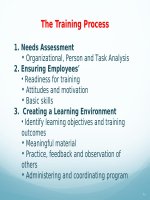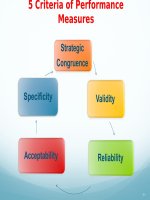Lecture Human resource management: Gaining a competitive advantage (9/e) – Chapter 12: Recognizing employee contributions with pay
Bạn đang xem bản rút gọn của tài liệu. Xem và tải ngay bản đầy đủ của tài liệu tại đây (300.77 KB, 11 trang )
Chapter 12
Recognizing Employee
Contributions with Pay
Copyright © 2015 McGrawHill Education. All rights reserved. No reproduction or distribution without the prior written consent of McGrawHill Education.
Introduction
Organizations have discretion in deciding how to pay.
Each employee’s pay is based upon individual performance,
profits, seniority, or other factors.
Regardless of cost differences, different pay programs can
have different consequences for productivity and return on
investment.
Pay plans used to energize, direct, or control employee
behavior.
Three theories that help to explain compensation’s effects are
the reinforcement theory, expectancy theory and the
agency theory; behavior–reward contingencies shape
behaviors.
122
Programs Recognizing Contributions
Programs differ by payment method, payout
frequency and ways of measuring performance.
Potential consequences include employees’
performance motivation and attraction, culture and
costs.
Management style and type of work influence
whether a pay program fits the situation.
Gain
Sharing
123
Merit Pay
Merit pay programs link performance-appraisal
ratings to annual pay increases.
A merit increase grid combines an employee’s
performance rating with employee’s position in a pay
range to determine size and frequency of his or her pay
increases.
Merit Bonus - Merit pay paid in the form of a bonus,
instead of a salary increase.
Some organizations provide guidelines regarding
percentage of employees who should fall into each
performance category.
124
Profit Sharing
Under profit sharing, payments are based
on a measure of organization performance
(profits), and payments do not become a part
of base pay.
Advantages profit sharing may encourage employees to think
more like owners.
labor costs are automatically reduced during
difficult economic times, and wealth is shared
during good times.
Disadvantage-workers may perceive their
performance has less to do with profit than top
management decisions over which they have little
125
Ownership
Ownership encourages employees to focus on
organization’s success, but may be less
motivational the larger the organization.
Stock options - plan that give employees the
opportunity to buy company stock at a
previously fixed price.
Employee stock ownership plans (ESOPs)
give employers certain tax and financial
advantages when stock is granted to
employees.
ESOPs can carry significant risk for
126
Gainsharing
Gainsharing – form of compensation based on
group or plant performance rather than
organizationwide profits that does not become
part of the employee’s base salary.
offers a means of sharing productivity gains with
employees.
Improves performance
127
Group Incentives and Team Awards
Group incentives measure performace in physical output.
Team award plans may use a broader range of performance
measures.
Individual competition may be replaced by competition
between groups or teams.
Individual incentives reward individual performance but
payments are not rolled into base pay. Performance is
measured as physical output rather than by subjective ratings.
128
Managerial and Executive Pay
Top managers and executives are a strategically
important group whose compensation warrants
special attention.
Some companies' rewards for executives are high
regardless of profitability or stock market
performance.
Executive pay can be linked to organizational
performance (agency theory).
Increased pressure from regulators and
shareholders to better link pay and performance.
Securities and Exchange Commission (SEC)
129
Process and Context Issues
3 issues represent areas of company discretion and pose
opportunities to compete effectively:
Employee Participation
in Decision Making
Pay & Process:
Intertwined Effects
Communication
1210
Summary
Programs vary as to whether they link pay to individual, group, or
organization performance. Often, it is a choice between different
combinations of programs that seek to balance individual, group,
and organization objectives.
Wages, bonuses, and other types of pay influence an employee’s
standard of living. Pay can be a powerful motivator.
An effective pay strategy promotes an organization’s success;
conversely, a poorly conceived pay strategy can have detrimental
effects.
4 categories of a balanced scorecard include financial, customer
internal and learning and growth.
1211









